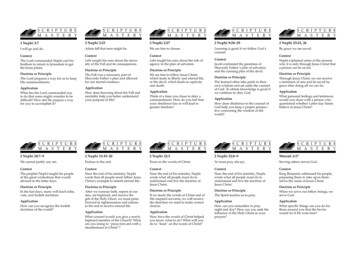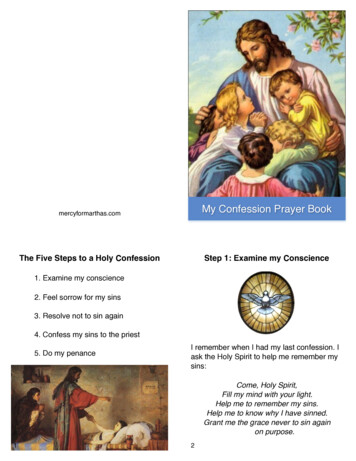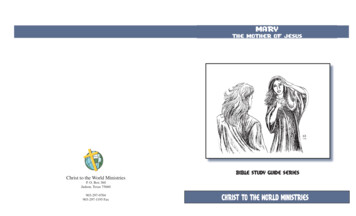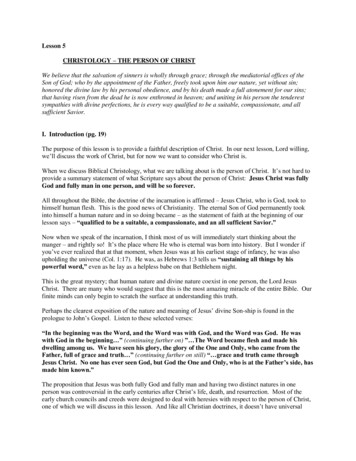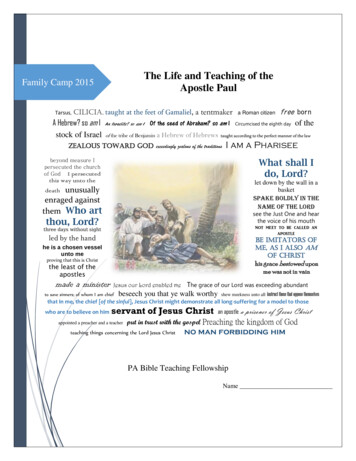
Transcription
1Reading Scripture through the Christ LensJune 2, 2018What is your goal when you study or teach the Bible? Bible study involves much more than trainingpeople to win a Bible trivia contest or expanding your biblical knowledge. Good teachers want to seechange in the lives of their students and in their own lives as well. Can any kind of Bible study be lifechanging? Think about the Pharisees of Jesus' day. They studied the Scriptures diligently andmeticulously, but Jesus said that they missed the point completely (cf. Jn 5:39-40). The question is notabout whether we study and teach the Bible, but about how we study and teach the Bible. So, how do youread the Bible? It’s not about whether you can win the national Bible Bee or not. The Bible study alonedoesn’t transform our lives. It's only Jesus who can change our lives. We must constantly remember thatall the Scriptures testify about Jesus Christ. The goal of our Bible study is to meet Jesus and to leadpeople to Him.1In this presentation, I’m going to talk about the Christ-centered reading and teaching of Scripture. Wemust make sure that our Bible studies are centered around Christ and his gospel. Our calling is toproclaim the gospel of Jesus Christ.All the Scriptures Testify about ChristThe New Testament teaches a Christocentric reading. Christocentric reading was a major feature of theReformation that taught the principle of sola scriptura (by Scripture alone). A Christ-focus isfundamental and indispensable to Bible study. Reading Scripture through the “Jesus lens” is reading it theway it was originally intended.2 The New Testament teaches that we must read the Old and NewTestament in light of Christ.Jesus’ Teaching:The New Testament authors interpret the Old Testament from the reality of Christ. Where did they learnthis? It was from Christ himself.On Easter morning, Jesus met two sorrowful, hopeless disciples on the Road to Emmaus and opened upthe Scriptures, showing that it spoke of him: “And he said to them, ‘O foolish ones, and slow of heart tobelieve all that the prophets have spoken! Was it not necessary that Christ should suffer these things andenter into his glory?’ And beginning with Moses and all the Prophets, he interpreted to them in all theScriptures the things concerning himself” (Lk 24:25-27). The risen Jesus taught the New Testamentbelievers to read all Scriptures in light of Christ, the crucified and risen Lord.The risen Jesus appeared to the disciples in the Upper Room. He ate broiled fish in their presence,showing the reality of his resurrection. He said in Lk 24:44-45: “ . everything written about me in theLaw of Moses and the Prophets and the Psalms must be fulfilled.” The risen Jesus taught that all Scriptureis about Christ, specifically his sufferings and glory.Mt 5 teaches that Jesus is the climax and fulfillment of the Old Testament (5:17). John teaches that allScripture is about Jesus Christ. See Jn 5:39, 46 and Jn 8:56. In John 5:39, Jesus said, “You search theScriptures because you think that in them you have eternal life; and it is they that bear witness about me.”The Scriptures bear witness about Jesus Christ. John 5:46 teaches that Jesus Christ fulfilled what Moseswrote about him. Jesus said in John 8:56, “Your father Abraham rejoiced that he would see my day. He12Cf. T. Wax, Gospel-centered Teaching, 17.Cf. M. William, How to Read the Bible through the Jesus Lens.
2saw it and was glad.” This is a striking statement about Abraham. Reflecting on God’s promise toAbraham in Genesis 12, Paul in Galatians 3:8 said: “And the Scripture, foreseeing that God would justifythe Gentiles by faith, preached the gospel beforehand to Abraham, saying, ‘In you shall all the nations beblessed.’”Apostles’ TeachingThe New Testament apostles read the Old Testament from the perspective of Jesus Christ, the crucifiedand risen Lord. Considering the risen Christ, the New Testament authors found the Old Testament filledwith promises of Christ, types of Christ, and references to Christ. In Acts 10:43, Luke testifies about whatPeter said, “To him [Christ] all the prophets bear witness that everyone who believes in him receivesforgiveness of sins through his name.”Apostle Paul teaches that Christ is the key to Scripture in 2 Corinthians 3:15-16: “Yes, to this daywhenever Moses is read a veil lies over their hearts. But when one turns to the Lord, the veil is removed.”The knowledge of Christ removes the veil from the Old Testament. The Old Testament becomes clearonly when understood through Christ who was predicted and prefigured there.Also Romans 1:1-4 teaches that the gospel of Jesus was promised in the Holy Scriptures: “Paul, a servantof Christ Jesus, called to be an apostle, set apart for the gospel of God, which he promised beforehandthrough his prophets in the holy Scriptures, concerning his Son, who was descended from Davidaccording to the flesh and was declared to be the Son of God in power according to the Spirit of holinessby his resurrection from the dead, Jesus Christ our Lord.” Cf. 2Ti 3:15.1 Peter 1:10-12 says, “Concerning this salvation, the prophets who prophesied about the grace that wasto be yours searched and inquired carefully, inquiring what person or time the Spirit of Christ in themwas indicating when he predicted the sufferings of Christ and the subsequent glories. It was revealed tothem that they were serving not themselves but you, in the things that have now been announced to youthrough those who preached the good news to you by the Holy Spirit sent from heaven, things into whichangels long to look.” The Old Testament prophesied about the grace of Jesus Christ. How did theprophets predict this? They did this by “the Spirit of Christ,” the Holy Spirit, who was in them. Like theNew Testament apostles, the Old Testament prophets prophesied about grace and salvation throughChrist’s sufferings and glories.According to Henry Shires in his Finding the Old Testament in the New, there are at least 1604 NewTestament citations of 1276 different Old Testament passages; several thousand more New Testamentpassages allude to or reflect Old Testament verses. Andrew E. Hill in his A Survey of the Old Testamentsays that 32 percent of the New Testament is composed of Old Testament quotations and allusions.3 Inshort, the New Testament writers interpret the Old Testament from a Christocentric perspective, that is, inlight of Jesus the Messiah, who has come.The Gospel-centeredness of the Whole BibleWhat does it practically mean that we must interpret all Scripture through the Christ lens? It means to becentered around the gospel of Jesus. As the New Testament teaches, the gospel is the center of the wholeBible. The main message of the New Testament church was that God revealed himself and acteddecisively in Jesus Christ. What is the gospel? John 3:16 says “God so loved the world that he gave hisone and only Son, that whoever believes in him shall not perish but have eternal life.” Jesus the Son ofGod, lived, died in our place, was triumphantly raised from the dead, and exalted as King of kings. Thiswas the fulfillment of God's promises in the Scriptures. In his name, we receive forgiveness of our sins.3Cited by S. Greidanus, Preaching Christ, chap 5.
3The Risen Lord is present on earth today through the Spirit, and he is coming again to bring about thenew heaven and new earth. His church proclaims the gospel by the power of the Spirit. Therefore, to beChrist-centered means to be centered around the whole gospel of Jesus.In turn, the gospel of Jesus is the gospel of the kingdom of God. As the Gospels testify, the center ofJesus’ work is the kingdom of God. In his redemptive history, God has planned and is establishing hiskingdom. Focusing on Christ is as broad as preaching the gospel of the kingdom of God.4 Therefore, to beChrist-centered means to focus on "Christ incarnate in the context of the full sweep of redemptivehistory."5 Refer to the gospel of the kingdom structures in the Bible (cf. Mt 1; cf. Ro 1:2).In short, the gospel of Jesus is the focal point of the Bible. Every part of Scripture is linked to the personand work of Christ. What does this imply for Bible reading? It means that no part of the Bible can becorrectly understood without him and his gospel. Therefore, proper interpretation of any part of the Biblerequires us to relate it to the gospel of Jesus.6Reading the Bible from the reality of Christ is a two-way street. We can understand the Old Testamentonly in light of Christ. And we can only properly understand Christ in light of the Old Testament. AChristocentric reading of Scripture is reciprocal. See the diagram below. Entry to the OT is made onlythrough the gospel of Jesus (A) that leads us to the Old Testament (B). With Christ (C), who is the focalpoint of the Bible, we follow progressive revelation until it leads us to its fulfillment in the gospel. In thisway, the redemptive acts of God in the Old Testament enable us to grasp the work of Christ.7See illustration of flowers:Sunflowers from the backside: Scripture is to be understood from the Old Testament to the NewTestament as flowers unfolding their petals to the morning sun.Sunflowers facing the Sun: The Old Testament is to be seen in light of Christ. “The Bible points forwardto Christ, backward to Christ, and again forward to Christ in His glorious return and reign. Forward,backward, and forward. Everywhere you turn, there is Christ.”8Connecting Each Story to the Grand Storyline of the BibleTo be gospel-centered, it is necessary for us to ask a basic question when we study a passage: How doesthis passage fit into the big story of Scripture? We should not read a Bible passage as we do with Aesop'sFables, which have unforgettable tales with a moral teaching (moralism). For example, in the Bible, thereare many heroes. What is the purpose of these stories? Are they simply examples to be followed? Noah:persistence; Abraham: faith; David: courage; Solomon: wisdom; Daniel: determination, etc.? Thisunderstanding is true, but only half true. This is “heroes and villains approach” that is basically man4G. Goldsworthy, Preaching the Whole Bible as Christian Scripture.S. Greidanus, Preaching Christ from the Old Testament, chap 1.6G. Goldsworthy, Preaching the Whole Bible as Christian Scripture, 84f.7See G. Goldsworthy, According to Plan, 55; cf. S. Greidanus, chap 5.8The Baptist Faith and Message; cited by T. Wax, Gospel-centered Teaching, 23.5
4centered and moralistic.9 Instead, we have to connect each story to the big storyline of the Bible. In thisway, we can see that the real hero of many stories is God. How is each part of the Bible linked to thegospel of Jesus? How do we make this connection? I present some helpful suggestions by T. Wax10.1. Read through the Bible chronologically. Probably the best way to see the big picture of theBible is to read it chronologically. Follow a chronological reading plan. "Read the Bible for Life" byGeorge Guthrie" "Read the Bible for Life" Chronological Reading Plan.2. Read at least one Bible overview book a year: The Big Picture Interactive Bible Storybook:Connecting Christ Throughout God's Story by The Gospel Project; The Jesus Storybook Bible by SallyLloyd Jones; How to Read the Bible through the Jesus Lens: A Guide to Christ-Focused Reading ofScripture by Michael Williams; God's Big Picture: Tracing the Storyline of the Bible by Vaughan Roberts;According to Plan: The Unfolding Revelation of God in the Bible by Graeme Goldsworthy.3. Locate your passage in the grand storyline of the Bible. For example, the story of Joseph andhis brothers can be a classic example of forgiveness, but we don’t stop there. Instead, we need to connectit to the grand storyline of the Bible: In the context of God’s promise to Abraham to bless the worldthrough his descendants (a foreshadowing of that future blessing); Joseph betrayed by his brothers,suffering unjustly, but was providentially lifted to a position to save many lives; what his brothers meantas evil against him turned to good (Gen 50:20). The story of Joseph is not only an example of forgiveness,good triumphing over evil. But in the grand narrative, it points to an even greater salvation in Jesus whowas betrayed and unjustly suffered at the hands of sinners, and was raised from the dead to bring theblessing of salvation to all peoples. The evil committed against Jesus on the cross was turned to good forthe salvation of the whole world.4. Point to Jesus as the ultimate answer to our sin problem. It is not about our interpretation skills.The goal is that we encounter Jesus, the Savior, as the Bible reveals him.Ways of Reading Scripture through the Christ LensThe risen Lord said that he was the fulfillment of Moses, the Prophets, and the Psalms, that is, the entireOld Testament (Luke 24:44). St. Augustine, a church father, formulated this biblical truth in his famousaxiom: “In the Old Testament the New is concealed, in the New the Old is revealed” (NovumTestamentum in Vetere latet, Vetus Testamentum in Novo patet). There are several ways of readingScripture that do justice to its intrinsic connection. I’ll point out four among the most important concepts:1. Redemptive-historical progression, 2. Promise and fulfillment, 3. Longitudinal themes, and 4.Typology (persons, events, institutions).Redemptive-historical ProgressionThe entire Bible is about God’s redemptive history. In God’s redemptive history, progressive revelation isthe general pattern of God’s revelation.11 God doesn’t reveal and work out everything at once. Rather, heacts consistently and progressively. Hebrews 1:1-2 teaches this clearly. “Long ago, at many times and inmany ways, God spoke to our fathers by the prophets, but in these last days he has spoken to us by hisSon, whom he appointed the heir of all things, through whom also he created the world.” In the OldTestament, God spoke by the prophets; in the last days, the New Testament era, God’s revelation wasgiven through his Son, the perfect representation of God.9D. Murray, Jesus on Every Page, 54ff.T. Wax, Gospel-centered Teaching, 45ff.11B. Ramm, Protestant Biblical Interpretation, 102.10
5Matthew teaches redemptive-historical progression in the genealogy of Jesus the Messiah: the son ofDavid and the son of Abraham. Christ is the successor of a royal line and the fulfillment of the promise.Luke traces Jesus' root through redemptive history all the way back to Adam, the son of God.Paul also uses redemptive-historical progression to preach Christ. Romans 1:1-3 teaches that the gospel ofGod was promised through his prophets. Jesus’ coming is the fulfillment of God’s promise made toAbraham (Gal 3:24). Jesus’ coming is the climax of the redemptive history: the fullness of the time hascome (Gal 4:4-5). According to Colossians 1:26, the mystery hidden throughout ages has been nowrevealed to his saints (cf. Eph 1:8-10). 1 Corinthians 15 proclaims that Jesus’ resurrection is the first fruitsof God’s eschatological salvation.Redemptive history or kingdom history is “the bedrock which supports all the other ways that lead toChrist in the New Testament.”12 From a perspective of the redemptive history, the New Testament linksChrist to Old Testament events which find their climax in him. Because God progressively works out hisredemptive plan, the New Testament writers preach that Christ is the culmination of a long series ofredemptive acts of God.Redemptive-historical progression detects some pivotal points in redemptive history. See the diagrambelow13.God’s redemptive history encompasses the scope from creation to new creation. In the Old Testament, wefind the blueprint of all redemptive history: creation-fall-redemption-new creation. The OT testifies aboutGod’s redemptive acts in Israel that point to Christ. The redemptive history culminates in Christ. The NTtestifies about God’s redemptive acts in Jesus that are now being proclaimed in church and human history.All this is moving toward New Creation, which is the consummation of God’s redemptive history.The theme of the Kingdom of God and covenant helpfully grasps the structure of redemptive history.14PrologueThe Kingdom inIsrael’s HistoryThe Kingdomrevealed inJesus Christ12KingdomThe Kingdom-PatternRebellion in the KingdomPrologue to RedemptionThe Kingdom PromisedThe Kingdom Promise ActivatedThe Kingdom ForeshadowedThe Kingdom in Prophetic HopeThe Kingdom at HandSpreading the KingdomThe Kingdom CompletedCovenantCreation CovenantFallThe Noahic CovenantThe Abrahamic CovenantThe Sinai CovenantThe Davidic CovenantThe New CovenantJesus the MessiahThe Community of the New CovenantThe Completion of the CovenantS. Greidanus, Preaching Christ, chap 6.Ibid., chap 6.14Cf. Peter J. Gentry & Stephen J. Wellum, Kingdom through Covenant; Graeme Goldsworthy, Gospel and Kingdom;Simon Vilbert, “Kingdom and Covenant in the New Testament.”13
6See the diagram below of the structure of the redemptive history.15Because redemptive history is a unified history, every part of this history should be interpreted in thecontext of its beginning and goal16. Reading the Bible from a viewpoint of redemptive history isespecially critical to interpreting the Old Testament. It reads the Old Testament from the focal point ofChrist. If we lose Christ from sight, we will end up reading the Old Testament like a pious Jew who doesnot know Christ. Therefore, we have to not only understand the passage in its historical context, but alsounderstand its message in the context of the whole Bible, keeping the focus on Christ.This does not mean that we do not impose the New Testament meanings on the Old. The redemptivehistorical way does not bypass the literal-grammatical interpretation. Rather, it seeks to understand an OldTestament passage first in its own historical-cultural context. “After we have heard a passage the wayIsrael heard it, we can move on to understand this message in the broad contexts of the whole canon ofthe Bible and the whole of redemptive history.”17 So, we have to know the main point of the author andspend enough time in the passage. Then, we can get on the road to Christ in the context of the wholeBible. Here are basic rules of redemptive-historical reading: First, understand the passage in its ownhistorical context. Next, understand the message in the context of the entire Bible and the gospel.The below diagram is a wrong model: Texts without the context of redemptive history.Intuitive direct application ofindividual and unrelated texts (T) tohearers (H), ignoring salvationhistory structure of revelation15Diagram drawn, based on G. Goldsworthy, Preaching the Whole Bible as Christian Scripture and V. Roberts,God’s Big Picture.16S. Greidanus, chap 5.17S. Greidanus, chap 6.
7The diagram below shows contextual use of biblical texts, reading texts in a redemptive-historical context.The text (T) is first linked theologically to Christ as the focal point of all Scripture, and then theconnection is made to the reader (H).18In a redemptive-historical approach, we should also avoid the pitfall of a quick identification of Christwith Old Testament figures. For example, if one of the angels who appeared to Abraham in Genesis 18 isinterpreted as a direct reference to Christ, we neglect progressive revelation. This interpretation shortcircuits the task of preaching Christ as the fullness of God's self-revelation in his incarnate Son, Jesus.With that said, Christ-centered exposition of Scripture is not about finding Christ through mysteriousskills of allegory. The goal is not to find innovative ways of identifying Christ in every text, making aspecific reference to Jesus. Rather, the Christ-centered approach wants to show how every text contributesto the unfolding revelation of the grace of God that culminates in the person and work of Christ. It wantsto identify how every text functions in the redemptive context, furthering our understanding of who Christis, what God sent him to do, and why.19 This approach requires a sense of God’s redemptive history. Weneed to discern a progressive revelation of God’s grace throughout Scripture.When we take redemptive-historical progression seriously, we can distinguish times, so as not to create acontradiction in Scripture. So, we should not force a New Testament standard of morality or doctrineupon an Old Testament passage.20 This implies also that “not all texts stand in the same relationship tothe contemporary believer as others.”21 For example, there are differences between the way the Law ofMoses applies to Old Testament Israel in the wilderness and the way it applies to contemporary Christians.Promise and FulfillmentIn this section I largely follow S. Greidanus’ significant work, Preaching Christ from the OldTestament.22 Since the New Testament looks back at the Old Testament in light of the Messiah who hascome, the concept of promise-fulfillment is foundational in interpretation. This concept functions withinredemptive history because God makes his promises and fulfills them.In the New Testament, the category of promise-fulfillment is much broader than fulfillment of specificpromises in words. The word “fulfillment” was used for both promises and types. Matthew says: “all thistook place to fulfill what had been spoken by the Lord through the prophet” (1:22). But not all thequotations in Matthew’s Gospel are prophecies about the future. For example, Mt 2:15 says, “This was tofulfill what the Lord had spoken by the prophet, ‘Out of Egypt I called my son.’” This verse quotes Hosea18See G. Goldsworthy, Preaching the Whole Bible, 100.B. Chapell, Christ-centered Sermon, Introduction, xiii; Christ-centered Preaching, 279.20B. Ramm, Protestant Biblical Interpretation, 103-4.21G. Goldsworthy, Preaching the Whole Bible, 73.22See S. Greidanus, chap 5.19
811:1. However, the verse in Hosea is not a promise or prediction about the future, but a statement aboutthe past that God called Israel (Ex 4:22-23). In this case, Matthew uses the word "fulfill" not for thefulfillment of a promise, but for a type of Christ. So, the NT uses the word “fulfillment” for both promisesand types (cf. Mt 13:35; Ps 78:2). Fulfillment of OT types and promises is the way the NT reads the OT.Promise-Fulfillment in the Old and New TestamentIn the Old Testament, God gave his promises to his people. He works out his promises throughout history.Some promises are already fulfilled within the Old Testament. For example, a promise to Abrahamregarding a son (Gen 18:10) had been fulfilled (Gen 21:2): The Lord said, “I will surely return to youabout this time next year, and Sarah your wife shall have a son” (18:10); “And Sarah conceived and boreAbraham a son in his old age at the time of which God had spoken to him” (21:2).See promise of the land (Gen 17:8) and its fulfillment (Jos 21:43-45): “Thus the Lord gave to Israel allthe land that he swore to give to their fathers. And they took possession of it, and they settled there. Andthe Lord gave them rest on every side just as he had sworn to their fathers. Not one of all their enemieshad withstood them, for the Lord had given all their enemies into their hands. Not one word of all thegood promises that the Lord had made to the house of Israel had failed; all came to pass.”God gave warnings against the sins of Israel and when they didn’t listen to him, they went into exile in587 BC.Other promises still awaited fulfillment in the Old Testament: “in you all the families of the earth shall beblessed” (Gen 12:3); promise of the new creation (Isa 65); a kingdom that shall stand forever (Dan 2:44);“Your throne shall be established forever” (2Sa 7:16).Even already fulfilled promises in the OT point forward to the future (cf. Jos 21; Heb 4). The NewTestament teaches that Christ has fulfilled Old Testament types and promises: Jesus is the Son of Man(Dan 7:13-14), the Servant of the Lord (Isa 42:1-9; 49:1-13; 50:4-11; 52:13-53:12), the suffering Servantof the Lord (Isa 53:12). Jesus said that the Scripture must be fulfilled (Lk 22:37). Paul also uses the wayof promise-fulfillment to read Scripture and to preach Christ (cf. Ro 1:1-3; 1Co 15:3-4).Progressive FulfillmentWhen we apply the way of promise-fulfillment, there are some special rules to consider. The concept ofprogressive fulfillment is significant. God usually fulfills his promises progressively. In the OldTestament, a promise is fulfilled, yet it remains open to further fulfillment. The same is true with respectto Christ in the New Testament. As Christ fulfills Old Testament promises, he turns them into newpromises of an even larger scope.For example, in the Old Testament, God promised to make Abraham into a great nation and to bless allthe families of the earth through him (Gen 12:2-3). (How do you study Genesis 12 in your Bible study andapply it?) This is a Messianic promise of God. God's promise to Abraham began to be fulfilled with thebirth of Isaac and continued to be fulfilled with Exodus and David, so on.The progressive fulfillment of God’s promise to Abraham in the Old Testament looks as follows:In Acts 2:16-21, when Peter on the day of Pentecost declared, “This is what was spoken through theprophet Joel,” he was talking about the fulfillment of promises through Joel. At the same time, several of
9Joel's predictions still await fulfillment such as “the sun shall be turned to darkness, and the moon toblood, before the great and terrible day of the Lord comes” (Joel 2:31).In Isaiah 7:11-17, the Lord gave a promise of Immanuel and defeat of enemies. The sign of Immanuelwas fulfilled first sometime before 732 BC when Tiglath-Pileser defeated both countries (Syria andEphraim). But Mt 1:22-23 says, “All this took place to fulfill what had been spoken by the Lord throughthe prophet: 'Look, the virgin shall conceive and bear a son, and they shall name him Immanuel' whichmeans, 'God with us.’” The promise of “God is with us” finds further fulfillment in the promise of theHoly Spirit (Lk 24:49; Ac 2:4). “God is with us” will be ultimately fulfilled in a new heaven and newearth (Rev 21:3).A progressive fulfillment of this promise looks like the diagram below:As we observe a progressive fulfillment in the biblical promises, we first move from the promise of theOld Testament to the fulfillment in the New Testament and then go back again to the Old Testament text.Isaiah 61:1-4 say, “The Spirit of the Lord is upon me . They shall build up the ancient ruins . they shallrepair the ruined cities” (1,4). This promise was initially fulfilled in the years following 538 BC when theremnant returned from exile. And Jesus said in Luke 4:21, “Today this Scripture has been fulfilled in yourhearing.” Here Jesus did not mention “the day of vengeance of our God” (61:2). “The day of vengeance”still awaits its fulfillment in the future.The prophecy in Zechariah 9:9-10 was fulfilled in Jesus Christ when he entered Jerusalem. “This tookplace to fulfill what had been spoken though the prophet, saying, ‘Tell the daughter of Zion, Look, yourking is coming to you, humble, and mounted on a donkey, and on a colt, the foal of a donkey’” (Mt 21:45). After seeing its fulfillment in Jesus, we move back to the prophecy in the Old Testament, and wenotice elements not yet fulfilled: “He shall command peace to the nations; his dominion shall be from sea
10to sea, and from the River to the ends of the earth” (Zech 9:10). The fulfillment of this part is still in thefuture.In studying the Bible and interpreting many messianic promises, we need awareness of further fulfillment.Here are some examples: the promise for David’s house (2Sam 7); the promise regarding a serpentcrusher (protoevangelium in Gen 3:15); “to your offspring I will give this land” (Gen 12:7); “though youroffspring all nations on earth will be blessed” (Gen 22:18). In interpreting messianic promises, we shouldkeep further fulfillment in mind. This enlarges our vision to the full scope of kingdom history. This helpsus to have the prophets’ vision of God’s glory that fills the whole earth.Longitudinal Themes of ScriptureScripture testifies about the gradual development of themes because God progressively reveals more ofhimself and his will as he carries out his salvation plan in history.23 Those themes include kingdom,covenant, paradise and exile, presence of God and worship, rest and Sabbath, justice and judgment,righteousness and nakedness.24Kingdom: We are made to live as his people under God’s rule and blessing. But sin is rebellion againstthe true king. God works out his kingdom plan throughout history. Jesus is the true king and his death andresurrection broke the power of sin, death, and Satan over us. To serve him is the perfect freedom.Covenant: we are made to live in relationship with God. He established the covenant out of his sovereigngrace. We are made to be his people; he is our God. In this relationship we find the blessing of love,justice, freedom, and peace. If we break the covenant, there is the curse of slavery, judgment and death.How can the holy God still live among his people who are unfaithful? Jesus became the man of thecovenant who fulfilled the covenant perfectly and fully in our place. Those who are in Christ are in thenew covenant in his blood.Paradise and exile: due to our sins, we all are in exile. Salvation in the Old Testament includes living inthe Promised Land. Who can bring us back home? Only Jesus Christ who was exiled and abandoned onour behalf, can bring us home to a new heaven and earth where righteousness dwells.The presence of God and true worship: we are created to live in an intimate relationship with God in hispresence. How can sinners come near to a holy God? The Tabernacle/temple in the OT points to thegracious presence of God. In Jesus who opened the new way, we can come near to God (Heb 9-10).Rest and Sabbath: We are created to enjoy rest, but because we try to earn rest by our achievement (
2 saw it and was glad." This is a striking statement about Abraham. Reflecting on God's promise to Abraham in Genesis 12, Paul in Galatians 3:8 said: "And the Scripture, foreseeing that God would justify the Gentiles by faith, preached the gospel beforehand to Abraham, saying, 'In you shall all the nations be blessed.

